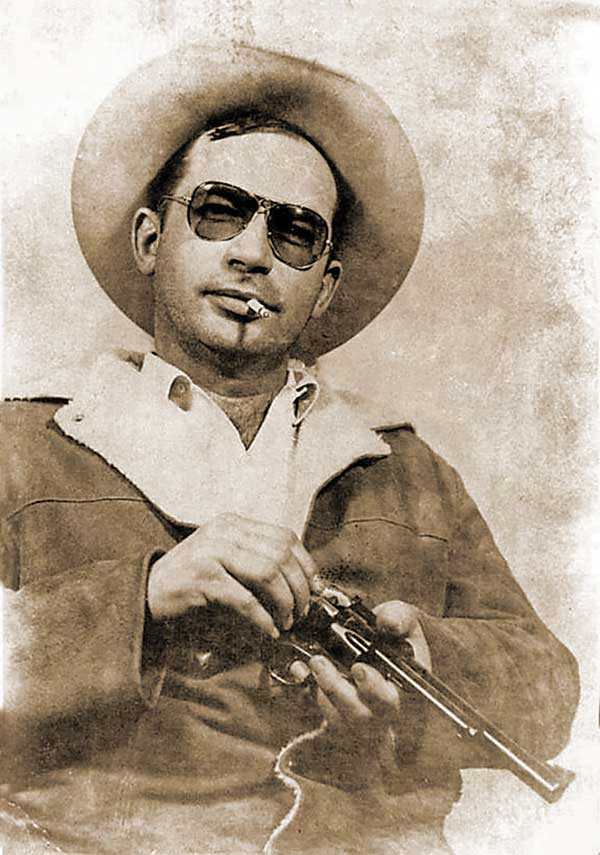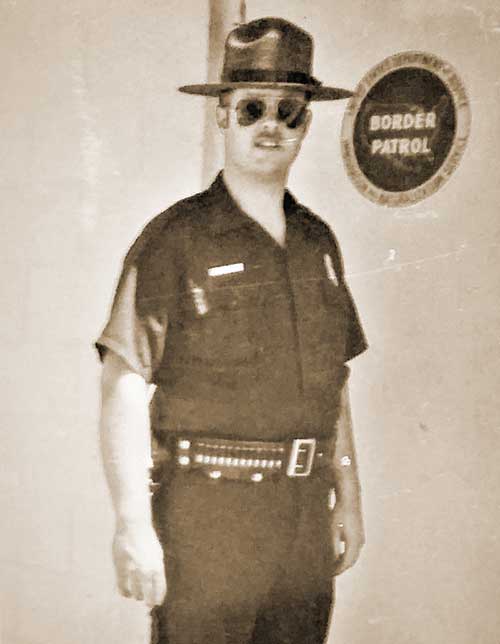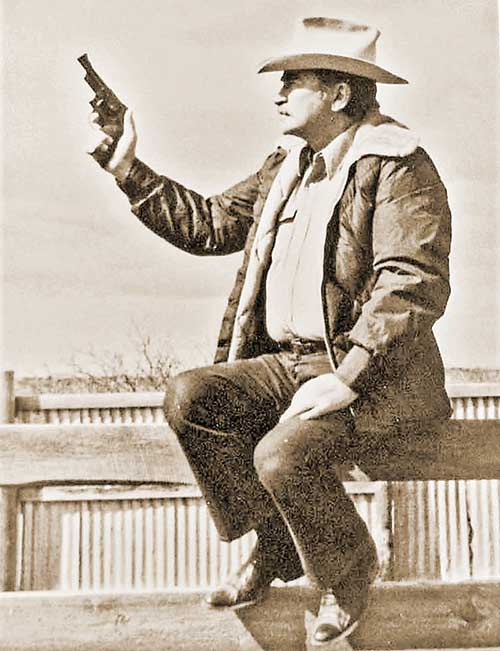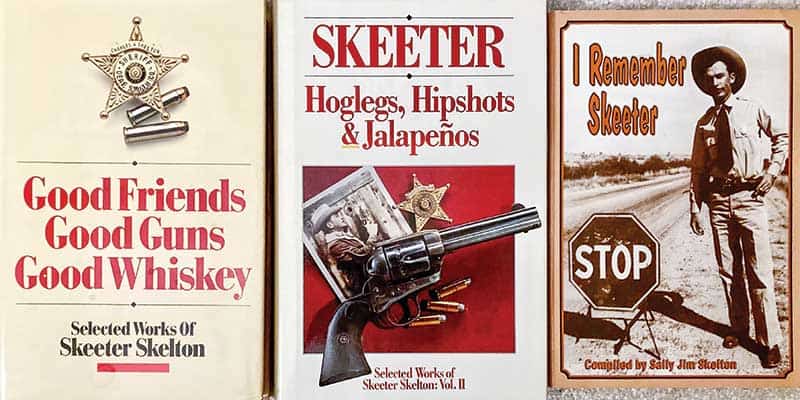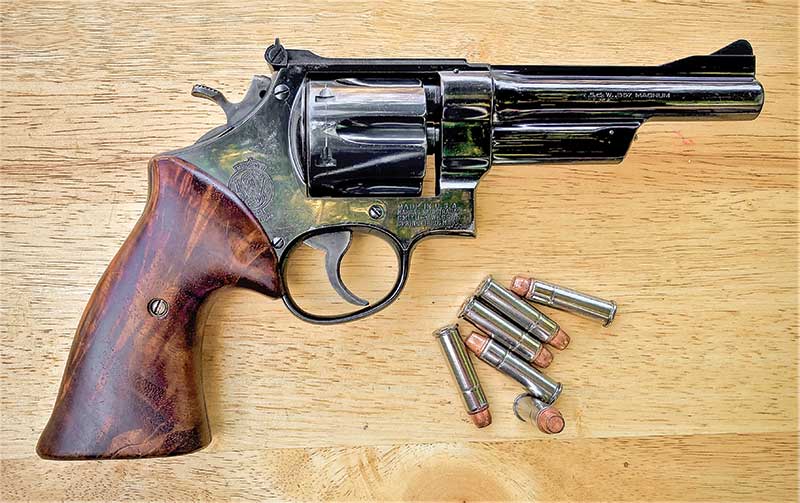
Category: Real men
The writing of such authors as Skeeter Skelton and other lawmen/scribes like Bill Jordan and Charles Askins influenced me to enter the field of law enforcement. After receiving a B.S. degree in Criminal Justice in 1976, I started out as a police officer, then deputy sheriff, and in the spring of 1982, I received my appointment as a Patrol Agent in the U.S. Border Patrol, El Paso Sector.
Home On The Range
During in-processing at ELP, the five other newbies who were hired with me found out El Paso might not be our new homes. I ended up stationed in Deming, N.M., but didn’t get to actually go there until after I’d graduated from the Border Patrol Academy.
At that time the academy was at the Federal Law Enforcement Training Center (FLETC) in Glynco, Ga. I spent the summer there learning immigration law, Spanish, federal law enforcement procedures, self-defense and physical training. Not only was South Georgia hot and humid, but there were delightful creatures like sand fleas, huge mosquitoes and horseflies to increase your misery at the obstacle course and on 5-mile runs. Somehow, I made it through the 17 weeks and got my gold Patrol Agent shield and .357 Magnum revolver.
My wife and son — still in diapers — had preceded me to Deming and rented us a nice house near the city library. She picked me up at the El Paso airport and we drove to Deming, where I beheld what I thought at the time was “Mayberry in New Mexico.” The Border Patrol Station was on the east end of town near the K-Mart and the city cemetery.
It was a cinder block building with a big garage out back, both painted in a lovely government “sea foam green” as were our patrol vehicles. Deming was a line-watch station, so mostly we drove south each day to the Columbus Port of Entry area and scanned the border line for illegal entrants. We also maintained drag roads paralleling the border at regular intervals that allowed us to locate and track the footprints of unlawful border crossers. We covered a huge area with just 20 agents.
For me and another rookie, we also spent one day a week in post-academy training, polishing our knowledge of immigration law and Spanish. Back then, after 6 ½ months, probationary agents had to pass a test given at ELP Sector; then if successful, another such test at the 10-month period. This helped to weed out individuals who made it through the academy, but were found wanting out in the field.
How I Met Skeeter
Shortly after my arrival in Deming, I was teamed with a big blond agent named Jim who was tasked with introducing me to our patrol area, including all of Luna County and parts of Hidalgo and Grant counties. One day we were heading east of a stretch of pavement called Rock Hound Road that led to a state park of the same name at the base of the Florida Mountains.
As we whizzed by a yellow brick house out in the boonies, I noted way out in the backyard was a backstop made from old railroad ties. I’m thinking, “must be a shooter who lives there,” when Jim exclaimed, “You know who lives there doncha?”
Me being me replied, “Ya Jim, I’ve lived in Luna County all of two weeks, I know everybody!” He then stated kinda nonchalantly, “Oh, that’s Skeeter Skelton’s house.” I was thunderstruck, my gun writer idol’s house! I’m sure my mouth hung open in disbelief. I then quipped, “I thought he said in his articles that he lives in Horse Thief, New Mexico?”
“That’s horse-pucky,” snorted Jim, “He lives right there!” This information, along with notations of surrounding landmarks, were immediately entered into my memory banks.
The Call
The next night, back home in Deming, I gingerly lifted the receiver from the wall-phone in the kitchen and with shaky hands dialed the number on the slip of paper. On the third ring Skeeter picked up on the other end. In a voice that I hoped wasn’t trembling, I introduced myself and explained to him our “wife connection” and the reason for my call. Skeeter exclaimed, “Congratulations on passing your 10, sure, come on out if you can this Saturday and we’ll chew the fat.”
On the appointed day, I put on my ball cap, western shirt, Wranglers and boots then splashed on a little Old Spice. Shooting Times had published a special magazine chock-full of some of Skeeter’s best articles entitled “Skeeter Skelton on Handguns.” I rolled it up and put it in the back pocket of my jeans so Skeeter could inscribe it for me.
Remembering the route, I drove out to his house, parked in front, got out and knocked on the door, all without falling down. Skeeter opened the door and invited me inside with a big smile and a handshake.
We sat in the living room and chatted for about four hours and every so often, he’d excuse himself, go into another room and come back with a special handgun to show me. I was in Nirvana! We sipped a certain spirit-lifting brown liquid and I’ll have to admit, at my present age, even the happenings in an event so monumental have faded a bit from memory. I do recall another knock at the door and the arrival of some other guests. This was a bit distracting and not wanting to wear out my welcome, I politely thanked Skeeter for the audience and made my way back out to the car.
Oh, Good Grief!
As soon as my posterior settled onto the bench seat of my little Ford Fairmont, I felt something push into the seat back. In an instant it dawned on me what I’d forgotten: an autograph! The rolled-up magazine had gone unnoticed in the living room as I was so “ga-ga” sitting on the couch talking to a legend. Now, the realization I’d forgotten all about it hit me like a sucker-punch to the gut.
I was sick and angry at myself, but I was also too embarrassed to go back, knock on the door and look like dumb-bunny. I started the engine, shifted to drive and headed back to “Mi Casa” in Deming. This was the first — and last — time I ever saw Skeeter Skelton …
He fought in WWI and then in the Kyber Pass area with his beloved Ghurkas. When WWII came he fought in the Ethiopia and East Africa campaigns.
He was then moved to Burma in 1942. Where he saved his Corp from utter defeat. Then he was made Army Commander & proceeded to reorganised and trained a beaten army (The 14th “Forgotten Army”) Where he made them into the army which gave the Imperial Japanese Army their biggest defeat (up to that date) in the battles of Kohima and Imphal, battles in which the IJA suffered 60%+ fatalities.
He then launched attacks into Burma and defeated the IJA repeatedly.
In some battles the IJA casualties were reportedly 100 dead Japanese per 1 Allied (mainly Indian) Army casualties.

It was 1861 when Michigan’s legislature dismissed the idea of George Copway — a popular Methodist minister and Chippewa — to recruit a regiment of Great Lakes Native Americans who he claimed were “inured to hardships, fleet as deer, shrewd, and cautious.” However, much had changed in the span of two years, including the imposition of a federally imposed draft, quotas to be filled by each state, and the already-spilt blood of thousands of Michiganders. As such, Michigan began to seek out Native American soldiers to support the Union war efforts.
Col. Charles V. DeLand, a veteran of the 9th Michigan Infantry, and a troop of eager recruiters were particularly interested in finding stealthy men with acute marksmanship to join a regiment of sharpshooters — particularly, in Company K of the 1st Michigan Sharpshooters. But these recruits needed an incentive, like the promise of payment, meals, and the possibility of negotiating the protection of their traditional homelands from outsider incursion.
In a time when Native Americans feared losing their homes, military service spurred a glimmer of hope. Saginaw Chippewa Chief Nockkechickfawme gave the young men of his tribe even more motivation when he sharply warned of a Confederate overtaking where “there will be no protection for us; we shall be driven from our homes, our lands, and the graves of our friends.” Ottawa Chief Pawbawme drew from his fellow chief’s influence, sparking the enlistment of approximately two dozen more men with his fiery oration.
Upon their departure by steamer, the Ottawa-Ojibwa men were seen off by a great majority of their community. Among these departing warriors was Antoine Scott, who would later be recommended twice for the Medal of Honor but would never be awarded the great recognition.
Another was Thomas Kechittigo — known to many as “Big Tom” — who had originally been refused enlistment in 1861 but would climb the ranks to become a sergeant in Company K. Recruits came from Oceana County, Bear River, Little Traverse, Charlevoix, La Croix and near Saginaw.
Of those who drove enlistments, a shining star was Second Lieut. Garrett A. Graveraet. A young man of only 23, the multi-talented Graveraet became an officer and led an impressive recruitment drive to strengthen the ranks of Company K. He even signed up his own father, the 55-year-old Henry Graveraet, who shaved off 10 years from his true age during enlistment and was the company’s only non-native soldier.
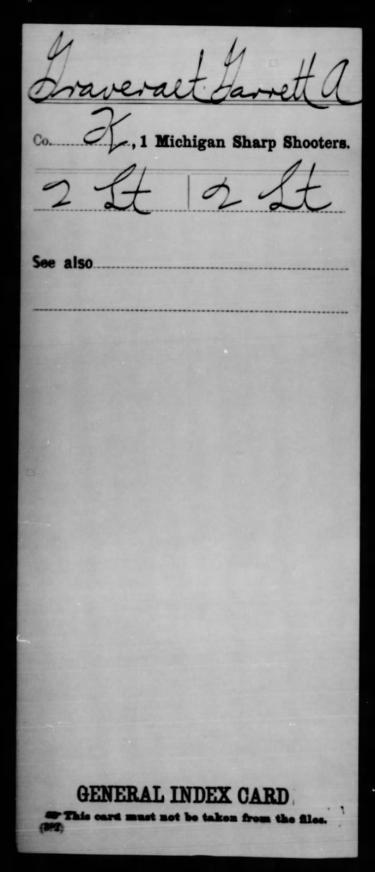
Following recruitment, the men of Company K were met with vigorous training. So, while veteran Colonel DeLand and part of the Michigan regiment sought out the Confederate raider John Hunt Morgan in Indiana, Graveraet — along with Capt. Edwin V. Andress and First Lieut. William Driggs — drilled the recruits of the new company into shape.
They were so effective that upon DeLand’s return, mustering officer Lieut. Col. John R. Smith noted that the recruits were “the stuff, no doubt, of which good sharpshooters can easily be made.” And these native troops were promised the same benefits as white soldiers, such as $13 pay a month — outweighing the $10 monthly pay that U.S. Colored Troops (USCTs) received until equal pay was mandated.
Despite that difference, those in Company K began their wartime service by defending military storehouses and guarding Confederate prisoners — a path reflective of many USCTs’ entry into military service.
Ordered to guard prisoners of war at Camp Douglas outside Chicago, the company experienced the bitter taste of camp life, as they faced not only boredom but also disease and desertion. Additionally, fellow soldiers and Chicago civilians were fascinated by the culture that accompanied Company K.
It wasn’t until March 8, 1864, that orders came in, directing the 1st Michigan Sharpshooters to Annapolis, Maryland, where they would rendezvous with Maj. Gen. Ambrose Burnside’s IX Corps of the Army of the Potomac. Arriving as Lieut. Gen. U.S. Grant started upon the Overland Campaign, the sturdy soldiers of Company K were inserted into the whirlwind of battle.
Their first foray into combat came with the Battle of the Wilderness on May 6, 1864, when the native soldiers engaged with Confederate forces south of Saunders’ Field. They used the brush and mud of their surroundings to camouflage their uniforms and, with an acute aptitude for sharpshooting and skirmishing, dove into battle with great determination. Mortally wounded in the fighting, Sergeant Charles Allen was the first casualty of war to come out of Company K.
However, the dark side of war only intensified for Company K, as days later — on May 12, 1864 — they were attacked by North Carolinians under Brig. Gen. James H. Lane during the Battle of Spotsylvania Court House. Ten more of the company’s men were lost as a result of the fighting.
By June 17, 1864, the Army of the Potomac had moved south of the James River and Company K was again swept into combat when the 1st Michigan were included in Brig. Gen. Orlando Willcox’s poorly executed attack on a Confederate salient around Petersburg, Virginia.
While the sharpshooters obtained possession of Confederate breastworks, they were also isolated and soon-to-be surrounded by enemy forces under Brig. Gen. Matthew Ransom. The already dissipated native soldiers battled on, engaging in hand-to-hand combat that covered the retreat of their fellow soldiers, but were ultimately overwhelmed by the Confederates.
Company K suffered two casualties from the incident, including Oliver Arpetargezhik and the young, bright Lieutenant Graveraet. The young Graveraet fell only days after the combat death of the elder Graveraet.
However, the impact of the June 17 fighting brought about a fate worse than death for more than 80 soldiers from the 1st Michigan, including 14 men from Company K, who were captured by the enemy. Prisoners of war, these soldiers were sent to the notorious Andersonville Prison, where about 50% of these men didn’t make it out alive.
For those who avoided Andersonville, the following month was full of picketing, sniping, and digging, and overall unsavory conditions around Petersburg. But despite the monotony, the native sharpshooters didn’t fail to impress their fellow soldiers. There was a certain instance in which Lieut. Freeman S. Bowley witnessed the sharpshooters intently watch a mile-far chimney for hours, waiting for the enemy force to show themselves. When it seemed like no development was in sight, a sudden shot was fired and a Confederate was seen falling from the chimney, after exposing a portion of his body.
By the end of July 1864, the Union Army was hell-bent on breaking the stalemate in Petersburg and devised a plan to dig a lengthy tunnel under the Confederate defenses, and then fill this space with explosives. On July 30, the Federals detonated the mine, blowing a gap in the Confederate defenses. The 2nd Brigade from Brigadier General Willcox’s division, which included the 1st Michigan, was the third unit to charge into the crater. There, they encountered masses of dazed and confused Federals, many of whom failed to reach enemy lines. They also came across Confederates who, after regrouping, fought back.
On the far left of the Federal charge, the native sharpshooters had gained a foothold on the Confederate defenses, but the circumstances prevented them from overcoming enemy forces. As those opposing soldiers rained fire into the crater, the Native American forces remained composed and determined amidst an impossible situation.
Accounts of the 1st Michigan’s actions at the Battle of the Crater are far and few between, but the regiment’s current-day historian successfully put the puzzle pieces together to understand its final actions at the fateful site. As Federal forces attempted to retreat, sharpshooters — including Sidney Haight, Charles Thatcher, and Company K’s Pvt. Antoine Scott — covered their comrades. Scott was among the last to remove himself from the chaos and was recommended twice for the Medal of Honor for his astounding bravery, but the Chippewa soldier passed in 1878 and never received recognition. At the Crater, it is estimated that Company K lost three men in battle, plus one wounded and six captured. In total, the 1st Michigan lost approximately 45 soldiers in the assault.
Following the immense devastation of the Crater, Company K’s native sharpshooters were present at the battles of Reams Station, Peebles’ Farm and — in the final year of the Civil War — Hatcher’s Run and final operations around Petersburg. Throughout the course of the conflict, about 150 native soldiers served in Company K.

Battle of Quebec 1759

